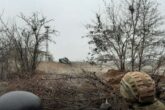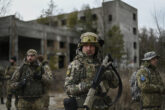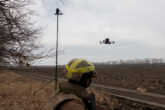May 08, 2024
Sharper: Nuclear Deterrence
Analysis from CNAS experts on the most critical challenges for U.S. foreign policy.
The United States faces two determined near-peer competitors with robust conventional military forces and increasingly advanced nuclear arsenals. In the Indo-Pacific, the People’s Republic of China (PRC) is expanding and modernizing its nuclear weapons and delivery systems while rejecting arms control meetings with the United States. In Europe, Russia continues to punctuate its invasion of Ukraine with periodic threats of tactical nuclear weapons use. Extended deterrence commitments and emerging technology races further complicate U.S. efforts to tailor its approach to its nuclear-armed adversaries. As this new era of nuclear deterrence takes hold, CNAS experts are examining the drivers of PRC and Russian nuclear strategy, and are providing recommendations to better manage nuclear crises and potential nuclear escalation. Read the latest edition of Sharper to explore their ideas and recommendations.
Features
Avoiding the Brink: Escalation Management in a War to Defend Taiwan
The United States is entering an unprecedented multipolar nuclear era that is far more complex and challenging than that of the Cold War. This report examines potential triggers, thresholds, and targets for Chinese nuclear use as well as options for the United States and its allies and partners to avoid and manage escalation. It uses the results of two exploratory tabletop exercises (TTXs) focused on how China’s expanding nuclear arsenal could impact the risk of nuclear escalation in a conventional conflict over Taiwan.
Assessing the Evolving Russian Nuclear Threat
Russia’s full-scale invasion of Ukraine in February 2022 reignited concerns about Moscow’s vast nuclear arsenal and the conditions under which the Kremlin might be willing to use these weapons. Moscow has gone to great lengths to stoke such concerns. At the start of the war, the Russian president publicly asked military leadership to place nuclear forces on higher alert (although there was no evidence of changes in Russian force posture). Over the course of the war, various figures inside the Kremlin have engaged in threatening nuclear rhetoric. Russia likely took these actions to coerce the United States and European countries to limit their support for Ukraine, divide the alliance by introducing concerns over escalation management, and prevent escalation to a direct conventional war with NATO, which the Kremlin continues to view as a superior military force.
Avoiding the Brink
The United States is entering an unprecedented multipolar nuclear era that is far more complex and challenging than that of the Cold War. This report examines potential trigge...
Assessing the Evolving Russian Nuclear Threat
Since Russia’s invasion of Ukraine, its nuclear rhetoric has become more permissive, more inconsistent, and more instrumental. Russia has also placed greater emphasis on milit...
Atomic Strait: How China’s Nuclear Buildup Shapes Security Dynamics with Taiwan and the United States
This report examines the intersection of China’s nuclear modernization with cross-Strait tensions, especially how they might play out during a crisis, contingency, or conflict involving China, Taiwan, and the United States. Beijing is rapidly modernizing its nuclear arsenal to make it larger and more sophisticated. Changes include increasing in warhead numbers from more than 400 today to potentially 700 by 2027 and more beyond, consolidating a nuclear triad, developing new delivery systems, and digging at least 300 new missile silos. Some factors still could constrain the growth of China’s arsenal or the policies that shape the way Chinese leaders employ it. They range from fissile material stocks to competing military spending priorities, considerations about China’s international reputation, and upholding Beijing’s claimed No First Use policy. But nearly all those constraining factors either already have weakened or could do so in the near future.
Disarming the Bomb: Distilling the Drivers and Disincentives for Iran's Nuclear Program
The CNAS Middle East Security Program designed and ran a scenario exercise in October 2022 to identify key factors that might accelerate or decelerate Iran’s nuclear program in 2024. The exercise explored how Iran, the United States, Israel, and the Gulf nations could prioritize their own national security objectives with respect to Iran’s nuclear program, along with the potential actions each might take to accomplish those objectives.
Atomic Strait: How China’s Nuclear Buildup Shapes Security Dynamics with Taiwan and the United States
This report examines the intersection of China’s nuclear modernization and cross-Strait tensions, especially how they might play out during a crisis, contingency, or conflict ...
Disarming the Bomb
Negotiations to return to the Joint Comprehensive Plan of Action (JCPOA), known commonly as the Iran nuclear deal, reached an impasse this past year. Further, Iran made parall...
Commentary
The Real Russian Nuclear Threat
To hear U.S. officials tell it, there is little risk that the war in Ukraine will lead to nuclear escalation. “We don’t have any indication that Mr. Putin has any intention to use weapons of mass destruction—let alone nuclear weapons,” said White House spokesperson John Kirby in January. At a Senate hearing in early May, Director of National Intelligence Avril Haines stated that Russia was “very unlikely” to use its nuclear arsenal. Yes, CIA Director William Burns said a February speech, the United States must take Putin’s nuclear saber rattling seriously. But the purpose of such rhetoric, Burns continued, was “to intimidate us, as well as our European allies and Ukraine.” It was not to signal that Russia was actually thinking about using its weapons.
AI Nuclear Weapons Catastrophe Can Be Avoided
In October 2022, the U.S. Department of Defense released its National Defense Strategy, which included a Nuclear Posture Review. Notably, the department committed to always maintain human control over nuclear weapons: “In all cases, the United States will maintain a human ‘in the loop’ for all actions critical to informing and executing decisions by the President to initiate and terminate nuclear weapon employment.”
This commitment is a valuable first step that other nuclear powers should follow. Still, it is not enough. Commitments like these are time and circumstance dependent. The U.S. military does not currently feel the need to produce and deploy such weapons, in part because it does not see other nuclear powers engaging in similar behavior. Thus, the threat of an artificial intelligence (AI)-enabled arms race is not a high-level concern for military planners. In the future, emerging AI features will only increase the potential for disaster through the possibility of semiautonomous or fully autonomous nuclear weapons.
The New Nuclear Age
There is nothing the United States can do to prevent China from joining it and Russia as the world’s top nuclear powers, but there are things that U.S. strategists and defense planners can do to mitigate the consequences. For starters, Washington will need to modernize its nuclear deterrent. But it will also need to engage in new ways of thinking about the nuclear balance of power and how, in a far more complex strategic environment, it can maintain deterrence and keep the nuclear peace.
The Real Russian Nuclear Threat
From the moment the country launched its invasion, Moscow has tried to intimidate the world by gesturing at its weapons....
AI Nuclear Weapons Catastrophe Can Be Avoided
AI-enabled nuclear weapons are particularly concerning due to their civilization-destroying nature....
The New Nuclear Age
In this precarious new strategic environment, it will be crucial for the United States to anticipate new challenges and respond to them nimbly....
China’s Nuclear Buildup is About More Than Nukes
U.S.-China nuclear and strategic stability will be tested in the coming year after a spate of revelations in 2021 about Beijing’s nuclear program. It is expanding the size and sophistication of its arsenal, potentially growing its total stockpile to 1,000 warheads by 2030, or just over a quarter of America’s 3,800 warheads. China also has tested a weapon system that flies into orbit carrying a hypersonic weapon — missile systems that fly five times the speed of sound and can maneuver to avoid defenses — and dug hundreds of new silos for intercontinental ballistic missiles (ICBMs). In addition, Beijing is reportedly consolidating its nuclear triad of bombers, submarines, and ICBMs; moving to a launch-on-warning posture; and exploring new “exotic” nuclear systems.
These developments raise questions about what is motivating China to pursue such capabilities, how nuclear modernization connects to the larger regional security dynamic, and how Washington should respond.
A Fight Over Taiwan Could Go Nuclear
Beijing views Taiwan as a breakaway republic. If the Chinese Communist Party decides to invade the island, its leaders may not be able to accept failure without seriously harming the regime’s legitimacy. Thus, the CCP might be willing to take significant risks to ensure that the conflict ends on terms that it finds acceptable. That would mean convincing the United States and its allies that the costs of defending Taiwan are so high that it is not worth contesting the invasion. While China has several ways to achieve that goal, from Beijing’s perspective, using nuclear weapons may be the most effective means to keep the United States out of the conflict.
Biden Can Find Middle Ground in Heated Nuclear Debate
U.S. President Joe Biden is faced with competing pressures as his administration prepares to announce the results of the latest Nuclear Posture Review. The administration; the niche, but important, arms control community in Washington; and foreign allies have been hotly debating whether Washington should adopt a policy pledging that the United States will not be the first to use nuclear weapons in a crisis (a preemptive attack or first strike), referred to as a “no first use” policy, and that the sole purpose of nuclear weapons is to deter a nuclear attack against America and its allies, referred to as a “sole purpose” policy. Both sides fiercely argue their viewpoint—but a middle way is possible.
China’s Nuclear Buildup is About More Than Nukes
Pursuing nuclear and strategic stability between the United States and China will likely prove harder than ever — but it is perhaps more important than ever, too....
A Fight Over Taiwan Could Go Nuclear
A fight between China and the United States could very well go nuclear....
Biden Can Find Middle Ground in Heated Nuclear Debate
Declaring a no-first-use policy would inevitably be accompanied by making changes to U.S. force posture and structure....
In the News
Featuring commentary and analysis from CNAS expert, Dr. Duyeon Kim.
Duyeon Kim, adjunct senior fellow at the Center for a New American Security, discusses the meeting of a U.S.-South Korea consulting group in response to North Korea's nuclear threats. Watch the full interview with CNBC.
About the Sharper Series
The CNAS Sharper series features curated analysis and commentary from CNAS experts on the most critical challenges in U.S. foreign policy. From the future of America's relationship with China to the state of U.S. sanctions policy and more, each collection draws on the reports, interviews, and other commentaries produced by experts across the Center to explore how America can strengthen its competitive edge.
Thank you for registering! You will receive a confirmation email shortly. All CNAS events are free, open to the public, and viewable from cnas.org/live.
Stay up-to-date with report releases, events, major updates, and announcements from the Center for a New American Security.
More from CNAS
-
Defense / Transatlantic Security
When Defense Becomes Destruction: Austria-Hungary’s Mistake and Ukraine’s RiskThis article was originally posted on War on the Rocks. The southeastern Polish city of Przemyśl, with its elegant 19th century Habsburg-era train station, remains one of the ...
By Franz-Stefan Gady
-
Defense / Transatlantic Security
Ukraine’s Catch-22 MomentThis article was originally published in the Financial Times. In Joseph Heller’s wartime classic, Catch-22, the protagonist Yossarian seeks out the US army surgeon Doc Daneeka...
By Franz-Stefan Gady
-
CNAS Insights | Budgetary Own Goals Undermine “Speed and Volume”
On November 7, Secretary of Defense Pete Hegseth laid out a plan to overhaul the Department of Defense’s (DOD’s) acquisition system. Placing an emphasis on delivering new capa...
By Philip Sheers, Carlton Haelig & Stacie Pettyjohn
-
Drones: Who Is Making the New Weapons of War?
From Ukraine and Russia to Gaza and Sudan, drones have become a key weapon of war. Which companies are making them, and profiting from this rapidly expanding but controversial...
By Stacie Pettyjohn













